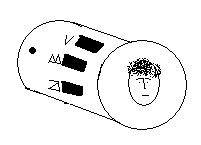I was inspired by
Angelo's post on Oscan abecedaria to dust off the old keyboard; for the future remain many exciting episodes from Italy and some brief things about the APA/AIA convention. The inscription that concerns me here is the following (format snagged from
Sauvage Noble):
"
Rix Fr 13Bronze cylinder, Casalbordino:
a b g d v z ḥ [i] k
Aside from 〈a〉, all the letters are/can be consonantal, without regard for voicing."
It's a bronze cylinder, found at Casalbordino in Abruzzo, now in the Museo Nazionale in Chieti.

This is basically what it looks like, although the cylinder is not as long relative to its diameter as I've sketched it. There's much more pronounced lip where at the end with the face. I'm sorry I don't have a photograph to share at the moment, and we're still waiting on the
Imagines Italicae project. They do have a somewhat useful entry on the
object. It is described as part of a ritual mechanism for distributing
sortes, that is, lots for fortune-telling. However, it may instead have been a part of a
ballista, a kind of torsion-powered catapult (
a diagram). The cylinder would fit on the end of the axle of the winding mechanism, the holes allowing the insertion of levers for winding back the string.
The letters that accompany what were originally ten holes evenly-spaced around the cylinder therefore indicate intervals of 36 degrees up to 324 (360 and 0 being of course the same). This division would give the artillerist a chance to adjust the tension with some degree of regularity, based on prior experience (probably the previous shot!). The cylinder probably dates to the period of the Social Wars, ca. 90 BCE, when many of the Italic tribes took arms against Roman hegemony.


4 comments:
Cool!
(What do you think about the missing e?)
@caelestis: I'm not sure; I'll really have to get to Chieti next time I'm over to have a look...
@irina: It goes more or less, "Quintus Ennius said that he had three hearts, because he was able to speak Greek, Oscan and Latin." How would that look in Romanian? I suppose you would call me a student of Latin, among other things.
Dan
Rhode Island College could use an antiquities prof Maybe you should ask them to start a dept. They do a lot of exchange programs.
I am looking for a book- preferably in english for my brother. History of Cerreto Sannita which is in Campania in prov of Benevento Italy.
Any ideas?
Also - are there any plans to dig up CERRETO VECCHIA buried in 1688 earthquake?
Fascinates me that beneath it must be ancient city - place was settled in 500BC I believe and last of Samnites etc etc FOUGHT THE ROMANS ETC WITH hANNIBAL/lUCANIANS
ps I hope you get a job
Betty Gordon
Hey, Dan. I'm afraid I don't buy your artillery interpretation. The texts don't mention a component like this, and I'm sure your average artillerist simply wound back the machine as far as it could go!
(Maybe when we can see a photo of the component, it's use will become apparent.)
Post a Comment